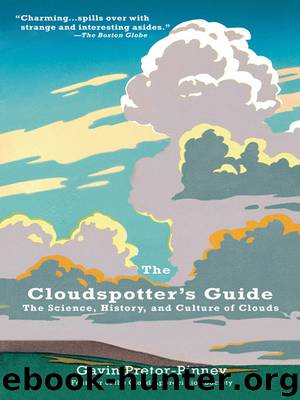The Cloudspotter's Guide by Gavin Pretor-pinney

Author:Gavin Pretor-pinney
Language: eng
Format: epub
Publisher: Penguin Group USA, Inc.
Published: 2006-06-17T16:00:00+00:00
So that’s how Cirrus are formed.
You wouldn’t think it, but Cirrus are in fact precipitating clouds. The reason they are not defined as such is that their ‘precipitation’ evaporates away in the warmer air below the cloud. Nevertheless, to look up at Cirrus clouds is to see snow–well, ice crystals, to be precise–falling too high to reach the ground. Cloudspotters may live in regions too warm for snow but, in the Cirrus clouds, they can still see how it looks from a few miles off.
The movement of the falling crystals, as they are whipped by the winds high in the troposphere, is what gives Cirrus their distinctive, flossy formations, known as ‘fallstreaks’. Up at the top of the troposphere, winds will often be as strong as 100–150mph. Forming in gales like this, Cirrus aren’t clouds that stick in one place for long.
Compared to low Cumulus gliding along in the breeze, these clouds can look almost stationary. Cloudspotters should remember, however, that the further away something is, the more difficult it is to notice its motion. In fact, Cirrus move a lot faster than Cumulus clouds. Not only are they the highest of the common clouds, they are also the fastest.
On average, wind speeds decrease with descent through the troposphere. So, as the ice crystals of a Cirrus cloud fall, they tend to pass into slower air currents below, where they lag behind. The varying temperatures and humidities on the way down can cause the crystals to grow and multiply in some regions and diminish in others. It is this variation in the wind speed, temperature and moisture content of the air through the crystals’ descent that determines the wavy forms of the Cirrus fallstreaks.
Download
This site does not store any files on its server. We only index and link to content provided by other sites. Please contact the content providers to delete copyright contents if any and email us, we'll remove relevant links or contents immediately.
How to Do Nothing by Jenny Odell(3232)
A Forest Journey by John Perlin(3027)
The Plant Messiah by Carlos Magdalena(2883)
Babylon's Ark by Lawrence Anthony(2620)
The ESV Study Bible by Crossway Bibles(2502)
Energy Myths and Realities by Vaclav Smil(2438)
Fatal Storm by Rob Mundle(2171)
Abbey in America by Murray John A(2049)
Witness Tree by Lynda V. Mapes(1887)
Brokeback Mountain by Annie Proulx(1782)
Client Earth by James Thornton(1733)
Shadows on the Gulf by Rowan Jacobsen(1717)
Coming Back to Life by Joanna Macy(1685)
Cosmos by Carl Sagan(1681)
Water Rights and the Environment in the United States by John Burch(1643)
Mycelium Running: How Mushrooms Can Help Save the World by Paul Stamets(1641)
Ten Billion by Stephen Emmott(1609)
The overachievers by Robbins Alexandra(1528)
Ecological Intelligence by Daniel Goleman(1507)
